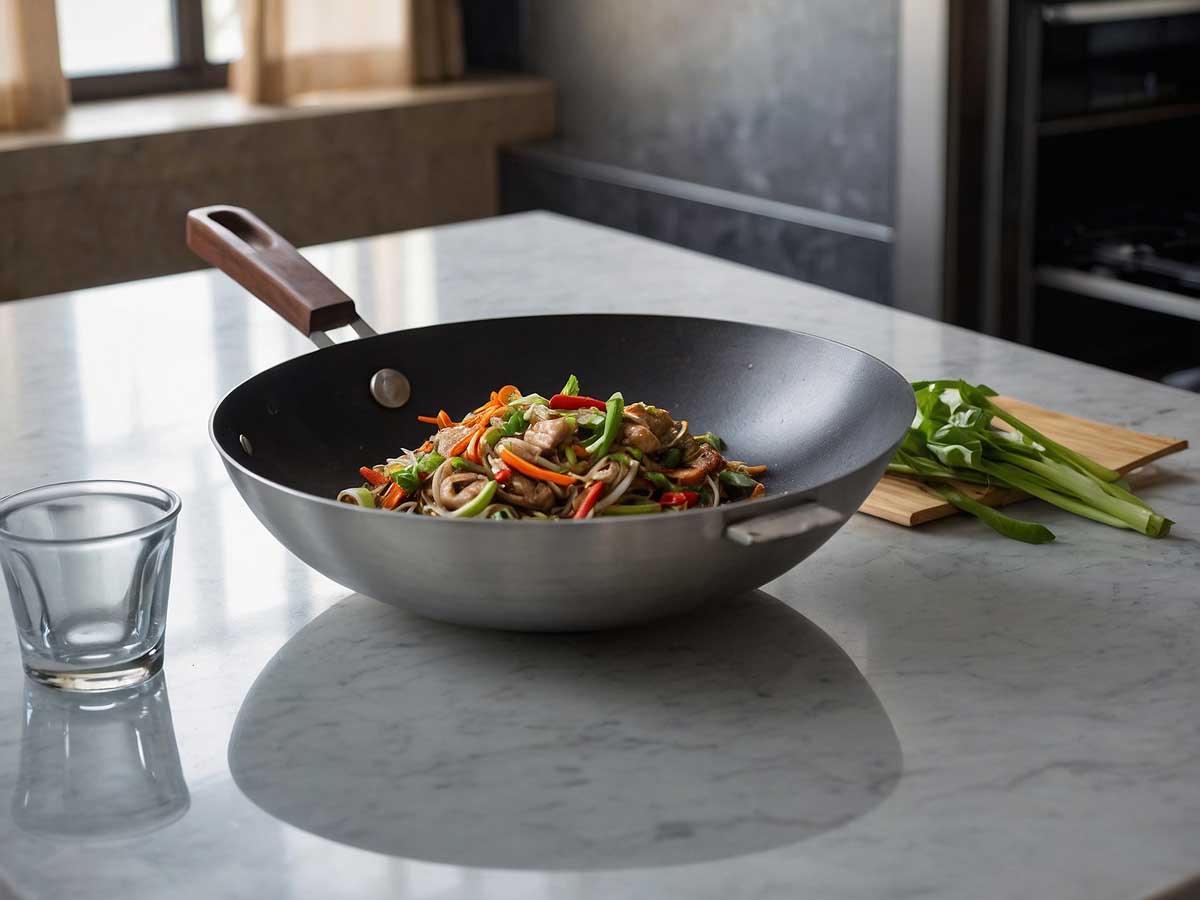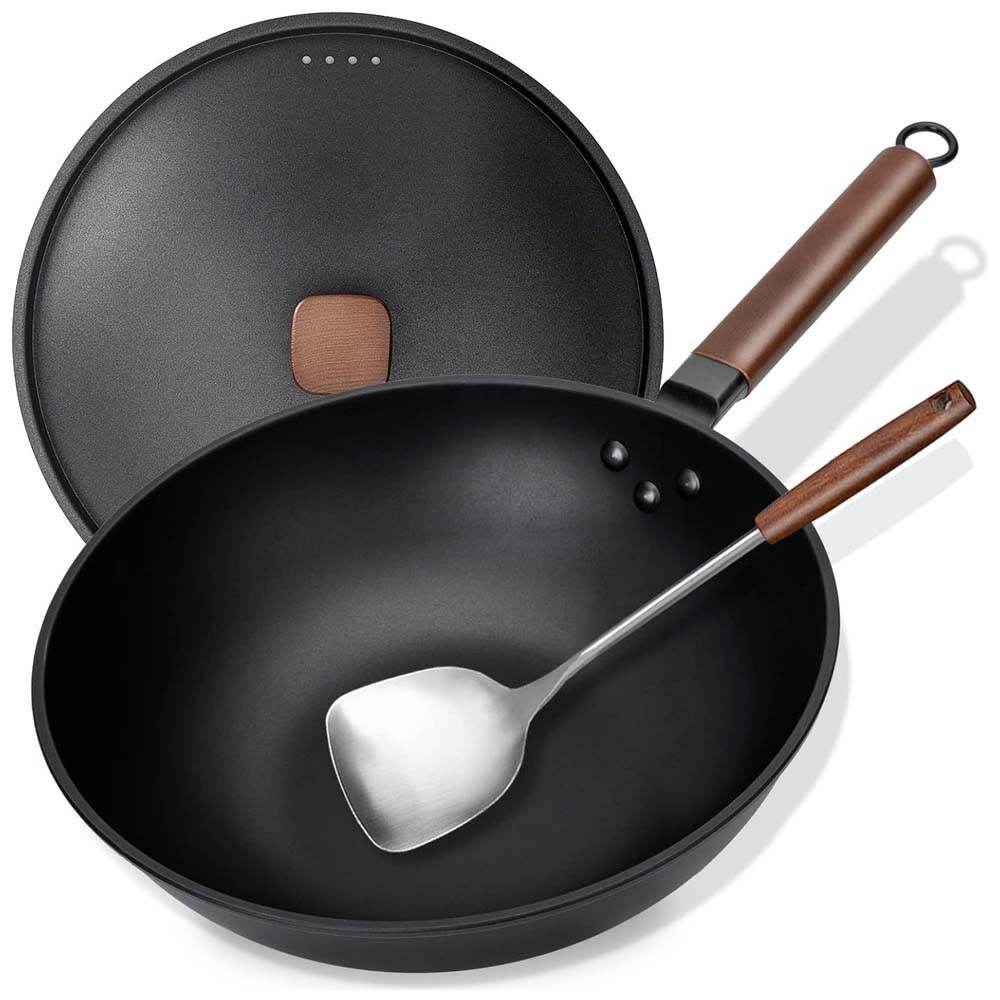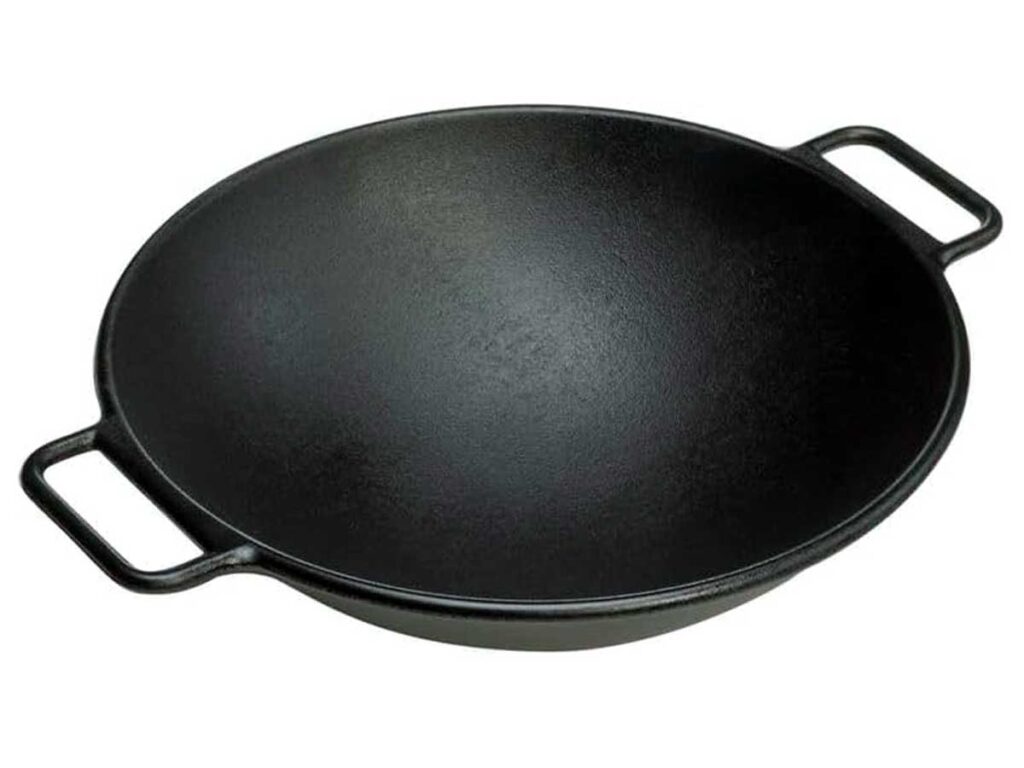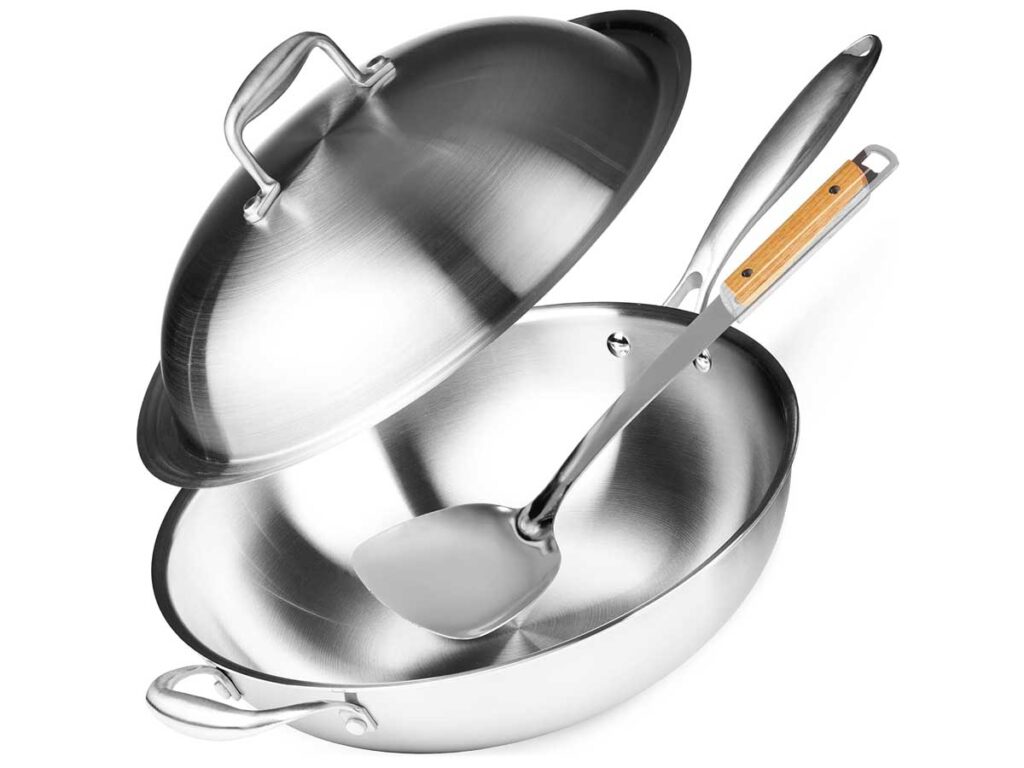What is a Wok? Discover Its Origin, Types, Uses, and Benefits

A wok is a deep, round-bottomed cooking pan commonly used in Chinese cuisine for stir-frying, steaming, and deep-frying. With origins dating back over 2,000 years, this versatile cookware has become indispensable in many kitchens worldwide. Its unique design allows for a variety of cooking techniques, from stir-frying to steaming and deep-frying.
In this article, I’ll explain what a wok is and why it’s such an essential tool for both amateur and professional chefs.
What is a Wok?
A wok is a deep, round-bottomed cooking pan, traditionally made from materials like carbon steel and cast iron. Its shape and design are specifically engineered to distribute heat evenly and efficiently, making it perfect for a variety of cooking methods. Example below:

Wok Shape
The wok’s deep, round-bottomed shape is one of its most notable features. This design creates a high heat zone at the bottom of the pan, ideal for stir-frying, while the sloped sides allow for ingredients to be moved up and away from the heat. This helps prevent burning and ensures that different components can cook at their optimal rates.
Wok Materials
Woks are typically made from carbon steel or cast iron. Each material has its benefits:
- Carbon Steel: This material is lightweight, heats up quickly, and responds well to temperature changes, making it a favorite among many chefs.
- Cast Iron: Although heavier, cast iron woks retain heat exceptionally well, providing a stable cooking temperature and making it ideal for slow-cooking methods.
Uses of Wok
The design of the wok makes it suitable for a variety of cooking techniques:
- Stir-frying: The high heat at the base is perfect for quickly cooking small, uniform pieces of food.
- Steaming: By adding a bamboo or metal steamer basket, the wok can be used to steam dumplings, fish, and vegetables.
- Deep-frying: The wok’s depth makes it ideal for deep-frying, as it requires less oil than a traditional pot.
- Smoking: With a rack and cover, the wok can be transformed into a smoker for fish or meat.
- Boiling and Braising: Its spacious interior can accommodate liquids for boiling noodles or braising meats and vegetables.
These features make the wok not just a Chinese cooking pan but an all-around versatile cookware piece, suitable for a wide range of dishes and cooking styles.
Types of Woks
There are several types of woks to consider, each with its unique benefits and drawbacks. These include carbon steel, cast iron, non-stick, and stainless steel woks. Additionally, the shape of the wok, whether traditional round-bottom or modern flat-bottom, can influence its performance and suitability for different cooking methods.
Carbon Steel Woks
Many kitchens highly favor carbon steel woks. Here’s why:
- Carbon Steel Benefits: These woks are lightweight and heat up quickly, making them responsive to temperature changes. This is crucial for stir-frying, where high heat is essential.
- Seasoning Carbon Steel Wok: To prevent food from sticking and to enhance flavor, carbon steel woks require seasoning. This involves coating the wok with a thin layer of oil and heating it to create a natural non-stick surface.

Popular carbon steel woks include brands like Joyce Chen and Craft Wok. To care for your carbon steel wok, avoid using soap when cleaning; instead, use hot water and a soft sponge. After washing, dry it thoroughly and apply a thin layer of oil to prevent rust.
Cast Iron Woks
Cast iron woks are known for their durability and excellent heat retention. Here are some key points:
- Cast Iron Durability: These woks are incredibly sturdy and can last a lifetime with proper care. They hold heat well, which is ideal for slow-cooking methods.
- Cast Iron Wok Care: Maintaining a cast iron wok involves regular seasoning to keep it non-stick and to prevent rust. After each use, clean it with hot water and a brush, dry it completely, and apply a thin layer of oil.

While cast iron woks are heavier and slower to heat up compared to carbon steel, their ability to maintain consistent heat makes them great for braising and deep-frying.
Non-Stick and Stainless Steel Woks
Non-stick woks and stainless steel woks each have their advantages and limitations:
- Non-Stick Wok: These woks are easy to clean and require no seasoning. They are perfect for low-fat cooking because they need less oil. However, non-stick coatings can wear off over time and are not suitable for high-heat cooking.
- Stainless Steel Wok: These woks are durable and resistant to rust and corrosion. They do not require seasoning and can be cleaned with soap and water. However, they can be prone to food sticking if not properly preheated and oiled.

Both types are versatile and can be used for various cooking methods, but they are best suited for specific tasks. Non-stick woks are great for delicate dishes like eggs and fish, while stainless steel woks are excellent for searing and browning meats.
Traditional Round-Bottom vs. Modern Flat-Bottom Woks
- Round-Bottom Wok: Traditional woks have a round bottom, which is perfect for stir-frying on a high flame, allowing for even heat distribution and easy tossing of ingredients. They are best used with a wok ring to stabilize them on a stovetop.
- Flat-Bottom Wok: Modern woks often have a flat bottom, making them more compatible with electric and induction stoves. They offer stability without the need for a wok ring and can still provide excellent heat distribution.
Choosing the right type of wok depends on your cooking needs, stove type, and personal preferences. Each type of wok has its unique features and care requirements, making them suitable for different cooking styles and techniques.
How to Choose the Right Wok
When choosing a wok, there are several factors to consider to ensure it fits your cooking needs, stove type, and personal preferences. Here are some tips to help you select the best wok for home use:
Size
- Small Wok (10-12 inches): Ideal for individuals or small families. It’s easy to handle and store.
- Medium Wok (12-14 inches): Versatile size suitable for most households. It offers enough space for cooking larger meals without being too bulky.
- Large Wok (14-16 inches or more): Best for large families or batch cooking. It requires more storage space and may be harder to handle.
Handle Type
- Single Long Handle: Provides good leverage for tossing ingredients. Common in carbon steel woks.
- Two Short Handles: Easier to lift and move, especially when the wok is full. Often found in cast iron and some stainless steel woks.
- Combination: Some woks feature a long handle with a helper handle on the opposite side for added control.
Additional Features
- Lids: Useful for steaming, simmering, and braising. Ensure the lid fits snugly to retain heat and moisture.
- Non-stick Coating: Consider this if you prefer easy cleanup and low-oil cooking. Note that non-stick woks aren’t suitable for high-heat cooking.
- Wok Rings: Necessary for stabilizing round-bottom woks on flat stovetops.
Stove Type
- Gas Stove: Works well with both round-bottom and flat-bottom woks. The high heat and open flame are ideal for traditional wok cooking.
- Electric/Induction Stove: Flat-bottom woks are recommended for better contact with the heat source. Ensure the wok is compatible with induction cooking if needed.
Material
Choose based on your cooking style and maintenance preferences:
- Carbon Steel: Lightweight, heats quickly, and requires seasoning.
- Cast Iron: Heavy, excellent heat retention, and requires seasoning.
- Stainless Steel: Durable, easy to clean, and no seasoning needed.
- Non-stick: Easy to clean but not suitable for high-heat cooking.
How to Use a Wok
Understanding how to use a wok properly can enhance your cooking experience. Here are basic instructions on seasoning, cooking techniques, and cleaning.
Seasoning a Wok
Seasoning helps create a natural non-stick surface and protects the wok from rust.
- Clean the Wok: Wash the new wok with warm, soapy water to remove any factory coating. Rinse thoroughly and dry completely.
- Heat the Wok: Place the wok on the stove over medium-high heat until it starts to smoke.
- Apply Oil: Add a thin layer of oil (like vegetable or peanut oil) and spread it evenly with a paper towel. Use tongs to hold the towel and avoid burns.
- Heat Again: Let the wok heat until it begins to smoke. Turn off the heat and let it cool.
- Repeat: Repeat the oil application and heating process 2-3 times until the wok develops a dark, non-stick coating.
Wok Cooking Techniques
- Stir-Frying: Heat the wok until it’s very hot. Add oil and swirl to coat the surface. Add ingredients and stir continuously to cook quickly and evenly.
- Steaming: Place a steaming rack or basket inside the wok. Add water below the rack, bring it to a boil, and place food on the rack. Cover with a lid.
- Deep-Frying: Fill the wok with oil (about halfway up the sides). Heat the oil and add food in small batches to avoid overcrowding.
- Smoking: Line the wok with foil and place a mixture of wood chips and sugar at the bottom. Add a rack above the mixture, place food on the rack, and cover tightly.
Cleaning a Wok
- After Cooking: Use warm water and a soft sponge to clean the wok. Avoid soap if the wok is seasoned, as it can strip the seasoning.
- Stubborn Residue: If needed, use a wok brush or bamboo scrubber. For tough spots, boil water in the wok to loosen food particles.
- Dry Thoroughly: Always dry the wok completely after washing to prevent rust.
- Reapply Oil: Lightly coat the wok with oil after drying to maintain the seasoning.
By following these steps and tips, you’ll be able to choose the right wok for your needs and use it effectively, ensuring great results in your cooking endeavors.
Frequently Asked Questions (FAQs):
Final Words
Having a wok in your kitchen is a true kitchen essential. Its unique design and cooking versatility make it suitable for a range of techniques, from stir-frying to steaming.
The wok benefits include even heat distribution, quick cooking times, and the ability to handle various dishes.
Choosing the right wok—whether carbon steel, cast iron, non-stick, or stainless steel—can significantly enhance your cooking experience. Proper selection based on your needs and stove type is key.
Maintaining your wok with regular seasoning and careful cleaning ensures it stays in great condition.
With a well-chosen and well-maintained wok, you can enjoy delicious and diverse meals right from your own kitchen.
Stay connected with Kit Yum for more knowledge base information.
